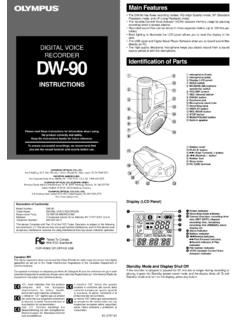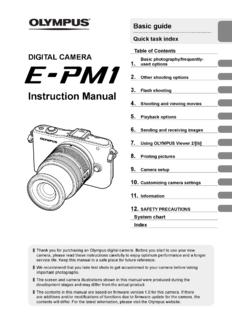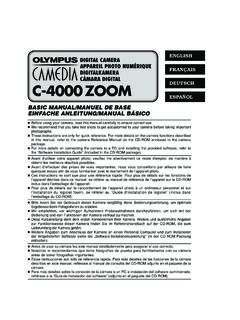Transcription of INSTRUCTIONS - Olympus Corporation
1 INSTRUCTIONS . Thank you for purchasing the Olympus OM-3Ti. This durable, lightweight SLR camera incorporates titanium a metal that's lighter than aluminum, yet six times stronger in the camera body. It is a single lens reflex camera with a mechanical shutter. Features include Multi Spot Metering, OTF Auto Flash and Super FP Flash Control System. Designed to facilitate serious photography with such professional-level techniques as daylight synchro-flash photography, the purpose of the OM-3Ti is to expand the sphere of creative photography. Before using the camera, we recommend that you read this instruction manual carefully, familiarizing yourself with the operating INSTRUCTIONS so you can get the very best performance and service life from your new camera.
2 Note: All the components of the Olympus OM-3Ti are carefully designed and their production and assembly is strictly controlled to enhance the unmatched performance of the system. If any interchangeable lenses, flashes, or accessories other than Olympus products are used, Olympus cannot be responsible for poor results or damage of the OM-3Ti. Correct Incorrect Operation Operation order Automatic operation Attention Press lightly Lamp on Lamp blinking Single beep Continuous beep 1. TABLE OF CONTENTS. < Preparation before Taking Pictures > < Taking Photographs (III) >. Dioptric Correction 5 Flash Photography . Mounting the Lens 7 Taking OTF Auto Flash Photographs 39. Loading the Batteries 9 Taking Daylight Synchro-Flash Photographs Checking the Batteries 11 (Super FP Flash Mode) 42.
3 Loading the Film 13 < Taking Photographs (IV) >. Setting the ISO Film Speed 16 Other Operations . < Taking Photographs (I) > Exposure Compensation in the OTF. Center Weighted Average Light Metering Auto Flash Mode 45. Center-Weighted Average Bulb Exposure 46. Light Metering 19 Using the Viewfinder Illuminator 47. Rewinding the Film 22 Changing the Focusing Screen 48. < Taking Photographs (II) > Changing the Camera Back 49. Spot Metering Attaching the Grip 50. How to Use Spot Metering 25. How to Clear Spot Metering 28. How to Use the Multi-Spot Metering 29. Highlight Control 32. Shadow Control 35. 2. TABLE OF CONTENTS. < For Your Creative Photography > < OM SYSTEM >. The Fascinating Results of Creative Exposure Flash Photography 79. and High-Speed Synchronization 53 OTF Auto Flash 80.
4 Center-Weighted Average Light Metering 55 Operation of T-Series Flash 80. OTF Auto Light Metering 56 Main Specifications of T-Series Flash 81. SPOT Metering (1) 57 Main Specifications of F280 82. SPOT Metering (2) 58 Using Electronic Flashes Other than the Shooting with One-Point Spot Metering 61 T-Series Flash Units 82. Shooting with Multi-Spot Metering 63 Bounce Flash 83. Sophisticated Multi-Spot Metering 65 Shooting with a Motor Drive 85. Highlight Control 67 Motor Drive Group 86. Shadow Control 69 Recordata Back 4 87. Viewfinder Information 71 Macrophotography 88. Exposure Compensation 72 Chart of Photographic Ranges 89. Depth of Field 72 Macro Photo Units 90. Depth of Field Scale 73 Finder Group Units 92. Preview Button 74 Selection of Filters 95.
5 Shutter Speeds 75 Handling Care 97. Bulb Exposure 76 Questions and Answers 99. Multiple Exposures 77 Description of Controls 104. Infrared Photography 77 Specifications 108. 3. < Preparations before Taking Pictures >. 4. Dioptric Correction The OM-3Ti permits dioptric adjustment according to your eyesight. 1. Remove the body cap. 5. 2. Pull out the diopter adjustment knob. 3. Turn and adjust the knob so that the matscreen appears sharp. 4. Push the knob back in until it locks. 6. Mounting the Lens 1. Remove the rear lens cap. 2. Align the red dots and rotate the lens clockwise until it locks. 7. 3. Remove the front lens cap. (Press in the mount tabs on the edges of the lens cap parallel with " Olympus "). Removing the Lens Press the lens release button and turn the lens counter- clockwise.
6 Mounting of a third-party lens can damage the automatic clear button. This disables the spot function. 8. Loading the Batteries Do not use different types of batteries or new and old batteries at the same time. If you are not likely to use the camera for a long period of time, remove the batteries before putting it away. 1. Remove the battery cover. 9. 2. Wipe battery surfaces clean. Make sure that +. signs are facing upwards. Use two SR44 silver oxide or LR44 alkaline manganese batteries or one CR-1/3N lithium battery. 10. Checking the Batteries Always check the batteries after inserting new batteries, when shooting in cold weather, or if the camera has not been used for a long time. Press the BATTERY CHECK button. 1. 11. The battery check indicator lights and the camera beeps to 2 tell you that the batteries have enough power.
7 As the battery power weakens, the signals will become intermittent then vanish completely when they are exhausted. 12. Loading the Film 1. Pull up on the rewind knob to open the camera back. Tear off the top of the film box and insert it into the memo holder. It will remind you which film you are using. 2. Insert the cartridge and push down the film rewind knob. (Always load the film in the shade.). 13. 3. Insert the film leader into the take-up spool. 4. Wind the film and make sure the sprocket teeth catch both the upper and lower film perforations. Take up the slack by turning the rewind crank 5 clockwise. 14. 6. Close the camera back until it clicks into place. Face the camera toward light and take two blind shots. 7 This will bring the film to the first frame.
8 15. Setting the ISO Film Speed Lift up the outer collar and rotate until the ISO speed 1 appears in the window. 16. 2. Align the exposure line A with the index B. If the exposure compensation dial does not turn to the desired ISO number, set it once at an intermediate value then repeat the procedure. 17. < Taking Photographs (I) >. Center-Weighted Average Light Metering . The OM-3Ti's exposure mode employs center-weighted average light metering. This meets a wide range of shooting requirements. 18. Center-Weighted Average Light Metering Press the shutter release lightly to activate the viewfinder 1 display. Focus on your subject. 2. 19. Set the bar graph tip to the fixed point between the arrows 3 by adjusting the aperture and/or shutter speed rings Fixed point Bar display The shutter speed you have set will be displayed in the 4 viewfinder.
9 Compose the shot and press the shutter release. 5. 20. When the subject is too bright, select a faster shutter speed. When the subject is too dark, select a slower shutter speed. The viewfinder display will go out after about 60 seconds. To turn the display back on again, touch the shutter release button lightly. 21. Rewinding the Film 1 When the exposure counter indicates the end of your roll of film. 2 Push the "R" Rewind Release Button. 22. 3. Fold out the rewind crank and wind it until the film tension is released. 4. Open the camera back by pulling up on the rewind knob and remove the film. 23. < Taking Photographs (II) >. Spot Metering . The spot metering system of the OM-3Ti enables you to control the exposure as you like. It insures perfect exposure of backlighted and high-contrast subjects and expands shooting possibilities for more creative photography.
10 24. How to Use Spot Metering Reference P 57-62. 1. Align the microprism area with the area you want to measure. (The spot metering range is outlined by the outer edge of the microprism.). Spot metering range 25. Press the spot button to take a meter reading. You will hear 2 an electronic sound and the word "SPOT" will appear in the viewfinder. The metered value is displayed by the mark. If you move the camera, another mark will indicate the exposure value in the center of the frame along with the spot metered value. Set the bar graph tip to the fixed point between the arrows 3 by adjusting the aperture and/or shutter speed rings. 26. The shutter speed you have set will be displayed in the 4 viewfinder. Press the shutter release to take the picture.
















